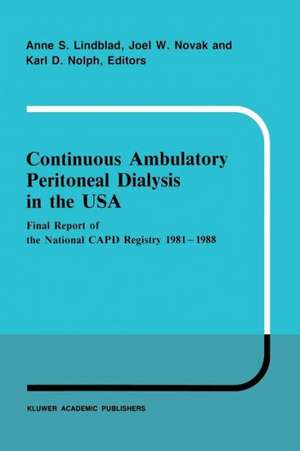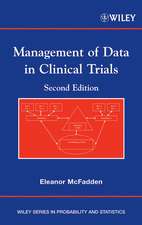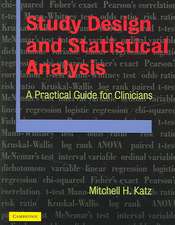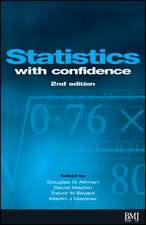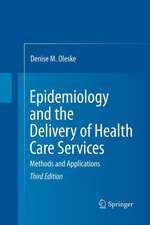Continuous Ambulatory Peritoneal Dialysis in the USA: Final Report of the National CAPD Registry 1981–1988: Developments in Nephrology, cartea 23
Editat de A.S. Lindblad, J.W. Novak, K.D. Nolphen Limba Engleză Paperback – 26 sep 2011
Din seria Developments in Nephrology
- 5%
 Preț: 1611.20 lei
Preț: 1611.20 lei - 5%
 Preț: 1417.91 lei
Preț: 1417.91 lei - 5%
 Preț: 719.02 lei
Preț: 719.02 lei - 5%
 Preț: 1418.83 lei
Preț: 1418.83 lei - 5%
 Preț: 1418.48 lei
Preț: 1418.48 lei - 5%
 Preț: 1924.28 lei
Preț: 1924.28 lei - 5%
 Preț: 364.89 lei
Preț: 364.89 lei - 5%
 Preț: 369.84 lei
Preț: 369.84 lei - 5%
 Preț: 1098.48 lei
Preț: 1098.48 lei - 5%
 Preț: 1436.77 lei
Preț: 1436.77 lei - 5%
 Preț: 377.52 lei
Preț: 377.52 lei - 5%
 Preț: 722.12 lei
Preț: 722.12 lei - 5%
 Preț: 1419.20 lei
Preț: 1419.20 lei - 5%
 Preț: 370.01 lei
Preț: 370.01 lei - 5%
 Preț: 385.57 lei
Preț: 385.57 lei - 5%
 Preț: 372.19 lei
Preț: 372.19 lei - 5%
 Preț: 1422.14 lei
Preț: 1422.14 lei - 5%
 Preț: 377.72 lei
Preț: 377.72 lei - 5%
 Preț: 713.18 lei
Preț: 713.18 lei - 5%
 Preț: 2358.20 lei
Preț: 2358.20 lei - 5%
 Preț: 382.43 lei
Preț: 382.43 lei - 5%
 Preț: 2119.55 lei
Preț: 2119.55 lei - 5%
 Preț: 1103.75 lei
Preț: 1103.75 lei - 5%
 Preț: 1423.58 lei
Preț: 1423.58 lei - 5%
 Preț: 1415.54 lei
Preț: 1415.54 lei - 5%
 Preț: 388.12 lei
Preț: 388.12 lei - 5%
 Preț: 365.10 lei
Preț: 365.10 lei - 5%
 Preț: 362.72 lei
Preț: 362.72 lei - 5%
 Preț: 373.12 lei
Preț: 373.12 lei - 5%
 Preț: 1095.36 lei
Preț: 1095.36 lei - 5%
 Preț: 371.30 lei
Preț: 371.30 lei - 5%
 Preț: 1098.27 lei
Preț: 1098.27 lei
Preț: 370.21 lei
Preț vechi: 389.70 lei
-5% Nou
Puncte Express: 555
Preț estimativ în valută:
70.84€ • 74.16$ • 58.62£
70.84€ • 74.16$ • 58.62£
Carte tipărită la comandă
Livrare economică 07-21 aprilie
Preluare comenzi: 021 569.72.76
Specificații
ISBN-13: 9789401069083
ISBN-10: 9401069085
Pagini: 324
Ilustrații: 272 p.
Dimensiuni: 155 x 235 x 17 mm
Greutate: 0.45 kg
Ediția:Softcover reprint of the original 1st ed. 1989
Editura: SPRINGER NETHERLANDS
Colecția Springer
Seria Developments in Nephrology
Locul publicării:Dordrecht, Netherlands
ISBN-10: 9401069085
Pagini: 324
Ilustrații: 272 p.
Dimensiuni: 155 x 235 x 17 mm
Greutate: 0.45 kg
Ediția:Softcover reprint of the original 1st ed. 1989
Editura: SPRINGER NETHERLANDS
Colecția Springer
Seria Developments in Nephrology
Locul publicării:Dordrecht, Netherlands
Public țintă
ResearchCuprins
Section 1 Introduction.- Section 2 Registry Patient Population.- Section 3 Patient Characteristics.- Section 4 Complications of Treatment.- Section 5 Termination of Continuous Peritoneal Dialysis.- Section 6 Special Reports—1988.- Section 7 Special Reports—1987.- Section 8 Special Reports—1986.- Section 9 Special Report—1985.- Section 10 Special Report—1984.- Appendices.- I. Executive Advisory Committee of the National CAPD Registry of the National Institutes of Health.- II. Participating Centers of the National CAPD Registry of the National Institutes of Health.- III. Bibliography of the National CAPD Registry of the National Institutes of Health.- Table of Exhibits.- Section 2 Registry Patient Population.- Exhibit 2-1 Number of Patients Registered by Class and Type of Dialysis.- 2-2 Number of Patients Registered by Class and Year of Registration.- 2-3 Number of Patients with Follow-up by Class and Type of Dialysis.- 2-4 Last Contact and Status According to Activity Classification of Center for Patients Last Reported to be on CAPD/CCPD.- 2-5 Currency of The National CAPD Registry Database by Class of Patient.- 2-6 Number of Patients Receiving CAPD at Year End.- 2-7 Census and Flow of The National CAPD Registry by Year.- Section 3 Patient Characteristics.- Exhibit 3-1 Percent of Patients with Selected Characteristics by Type of Therapy.- 3-2 CAPD—Age Distribution by Sex.- 3-3 CCPD—Age Distribution by Sex.- 3-4 CAPD—Age Distribution by Race.- 3-5 CCPD—Age Distribution by Race.- 3-6 CAPD—Distribution of Patients by Primary Renal Disease Type According to Year of Registration.- Section 4 Complications.- Exhibit 4-1 CAPD—Occurrence of Selected Complications by Class of Patients.- 4-2 CAPD—Cumulative Probability of Experiencing First Episode ofPeritonitis (Class 1 Patients Only).- 4-3 CAPD—Complication Rates by Year of Registration.- 4-4 CAPD—Cumulative Probabilities and 95% Confidence Intervals (C.I.) of Experiencing Selected Events for the First Time by Year Registered (Class 1 Patients Only).- 4-5 CAPD—Cumulative Probability of Experiencing First Exit Site/Tunnel Infection (Class 1 Patients Only).- 4-6 CAPD—Cumulative Probability of First Catheter.- Replacement (Class 1 Patients Only).- 4-7 CAPD—Cumulative Probability of First Complication (Class 1 Patients Only).- 4-8 CCPD—Occurrence of Selected Complications by.- Class of Patient.- 4-9 CCPD—Cumulative Probabilities and 95% Confidence Intervals (C.I.) of Experiencing Selected Events for the First Time by Number of Months on CCPD (Class 1 Patients Only).- Section 5 Termination of Continuous Peritoneal Dialysis.- Exhibit 5-1 CAPD—Cumulative Probability of Transfer (Class 1 Patients Only).- 5-2 CAPD—Cumulative Probability of Receiving a Kidney Transplant (Class 1 Patients Only).- 5-3 CAPD—Cumulative Probability of Death (Class 1 Patients Only).- 5-4 CAPD—Cumulative Probability of Discontinuing CAPD Therapy for any Reason (Class 1 Patients Only).- 5-5 CCPD—Cumulative Probability of Transfer (Class 1 Patients Only).- 5-6 CCPD—Cumulative Probability of Receiving a Kidney Transplant (Class 1 Patients Only).- 5-7 CAPD—Cumulative Probability of Death (Class 1 Patients Only).- 5-8 CCPD—Cumulative Probability of Discontinuing CCPD Therapy for Any Reason (Class 1 Patients Only).- 5-9 CAPD or CCPD—Cumulative Probability of Transplantation: Pediatrics vs. ‘Standard’ vs. ‘Other’.- 5-10 CAPD or CCPD—Cumulative Probability of.- Death: Pediatrics vs. ‘Standard’ vs. ‘Other’.- 5-11 CAPD or CCPD—Cumulative Probability of‘Technique Failure’: Pediatrics vs. ‘Standard’ vs. ‘Other’.- 5-12 Follow-up of Transfers to Hemodialysis Summary.- 5-13 Primary Reason for Leaving CAPD in Patients who Transferred from CAPD to Hemodialysis and Subsequently Returned to CAPD.- 5-14 Follow-up of Kidney Transplant Summary.- 5-15 Death Summary.
